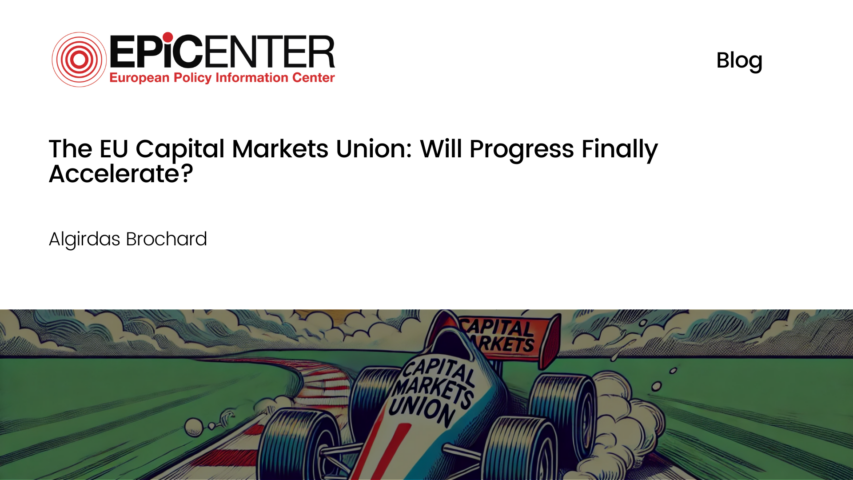The EU Capital Markets Union: Will Progress Finally Accelerate?

The EU Capital Markets Union: Will Progress Finally Accelerate?
Algirdas Brochard // 25 August 2017
The Capital Markets Union (CMU) was launched in 2014 by the European Commission to lower barriers to cross-border investment in the EU and to reduce Europe’s high dependence on bank funding. The Commission hopes that deeper and more integrated capital markets will lower the cost of funding and will make the financial system more resilient in the event of another financial crisis, notably by fostering more cross-border financial risk sharing.
Work on the CMU is set to accelerate in the upcoming months as the Commission aims to strengthen its capital markets in order to minimise the potential disruption caused by Brexit. Concerns, however, remain on when the envisioned framework will be in place, as previous proposals did not get swift parliamentary approval.
The idea behind the CMU is far from new. Already in 1996, the Giovannini Group was formed to identify inefficiencies in the EU financial market infrastructures and to propose practical solutions to improve market integration, specifically in the EU Clearing and Settlement Arrangements area. The Group released two reports, in 2001 and 2003, identifying 15 barriers to cross-border investments.
In particular, the 2001 report identified three main types of barriers. First, national differences in technical requirements, which includes differences in IT systems, restrictions to direct access to settlement systems by foreign institutions, different lengths of settlement cycles and the requirement that issues in listed securities be deposited exclusively in the local settlement system. Second, national differences in tax procedures, which includes transaction taxes in certain member states, exclusive rights to collection of withholding tax and inconsistent and complex taxation regulations in EU member states. Third, issues of legal certainty, which are related to the absence of an EU-wide framework for the treatment of interests in securities and differences in legal definitions of pledges, settlement finality and rights from securities.
Since the early 2000s progress to remove some of these obstacles (such as national restrictions on the location of securities) has been made. Nevertheless, a lot remains to be done to eliminate several of the other barriers, such as, for example, the absence of an EU-wide framework for the treatment of interests in fixed-income securities. For this reason, as of 2017, European capital markets remain highly fragmented and are still supervised by national authorities.
On 8 June 2017, after completing its Mid-term review of the CMU action plan, the European Commission published a new set of priorities to accelerate the completion of the CMU, a move partly designed as a response to Brexit. The new proposals include measures to strengthen the European Securities Market Authority (ESMA), a financial regulatory institution currently based in Paris and founded in 2011. A more unified regulatory supervision is necessary to remedy divergent supervisory approaches and is indeed possible to achieve – as the example of the Banking Union with the ECB as its single regulator demonstrates. Still, this extra step is attainable only with a more unified set of regulations. In fact, in addition to already diverging national rules, over the years, Member States have also created an extra layer of complexity by imposing additional requirements when transposing European directives into national law.
Indeed, what makes the completion of the CMU so difficult is that important barriers to cross-border investment cannot be addressed at a European level but only at a national level. A good example is related to the complex and lengthy country-specific withholding tax relief (WHT) procedures. WHT procedures are needed to avoid double taxation on cross-border investment. A recent report published by the Commission on 24 March 2017 highlights that cross-border investors have to provide extremely complex documentation and need to fill up to 56 separate national forms in order to successfully claim tax relief. Many of these documents cannot be filled online, whilst many others must be processed only through a local agent. The length of time it takes for a country to pay reclaims out varies considerably: a 2013 report by the Tax Barriers Advisory Group showed that, whereas the procedure took only a few weeks in Germany, it could, anecdotally, take over twenty years in Italy. In 2009, the Commission already asked Member States to simplify their WHT procedures and make them quicker, as it identified positive spill over effects when Member States had done so. Best practices are well known and Member States should legislate without any further delay to reduce the €8.4bn annual cost in foregone tax relief.
Finally, it is important to remember that achieving progress on the CMU at a European level is dependent on the European Parliament. A recent measure to adopt a common set of rules on securitisation (part of the CMU agenda) demonstrated that legislative progress within the Parliament remains a slow process. For this specific measure, Member States reached an agreement in December 2015 after just nine weeks of negotiations (an outcome described as a “record” by the then Commissioner for Financial Services, Lord Hill). The Parliament, however, refused to fast track this initiative and demanded a thorough review of the proposal, finalising its stance 14 months later. The three European institutions finally reached an agreement at the end of May 2017, twenty months after the Commission first submitted the proposal.
Different company laws, different tax legislations and different insolvency frameworks make it more difficult for cross-border investors to evaluate the risk they take when they invest in equities, bonds or loans issued in other EU jurisdictions. Consequently, progress on a European scale, as well as increased harmonisation between Member States’ laws, is needed if the EU wants to support the cross-border integration of capital markets across the continent.
Read the EPICENTER briefing about the European Commission public consultation on the capital markets union mid-term review 2017 here.
EPICENTER publications and contributions from our member think tanks are designed to promote the discussion of economic issues and the role of markets in solving economic and social problems. As with all EPICENTER publications, the views expressed here are those of the author and not EPICENTER or its member think tanks (which have no corporate view).



